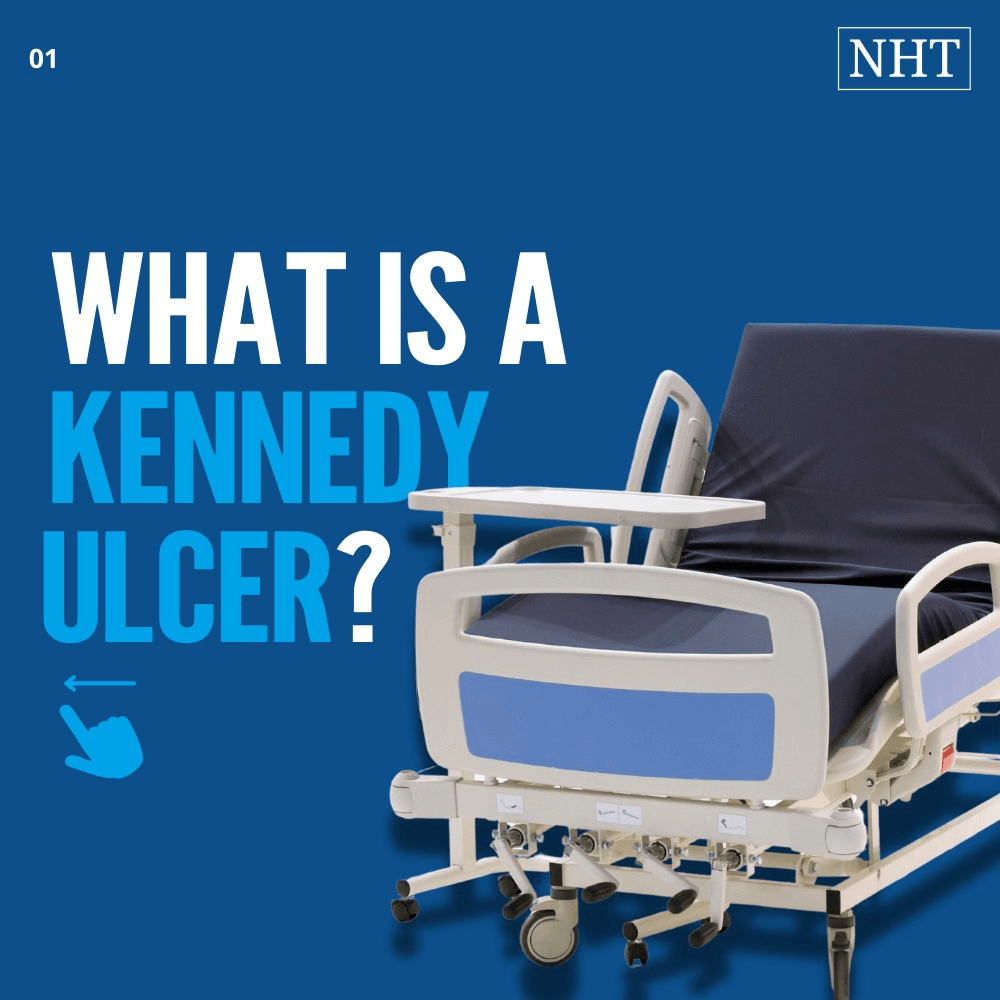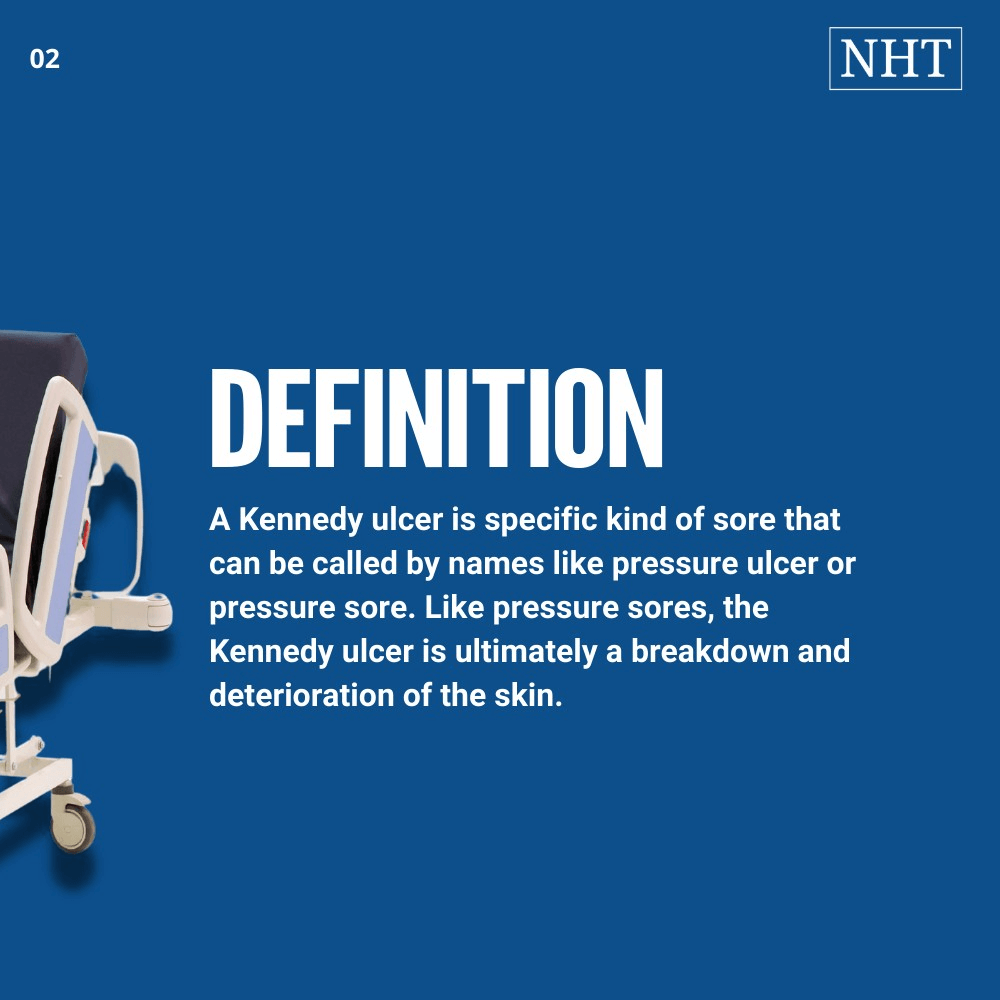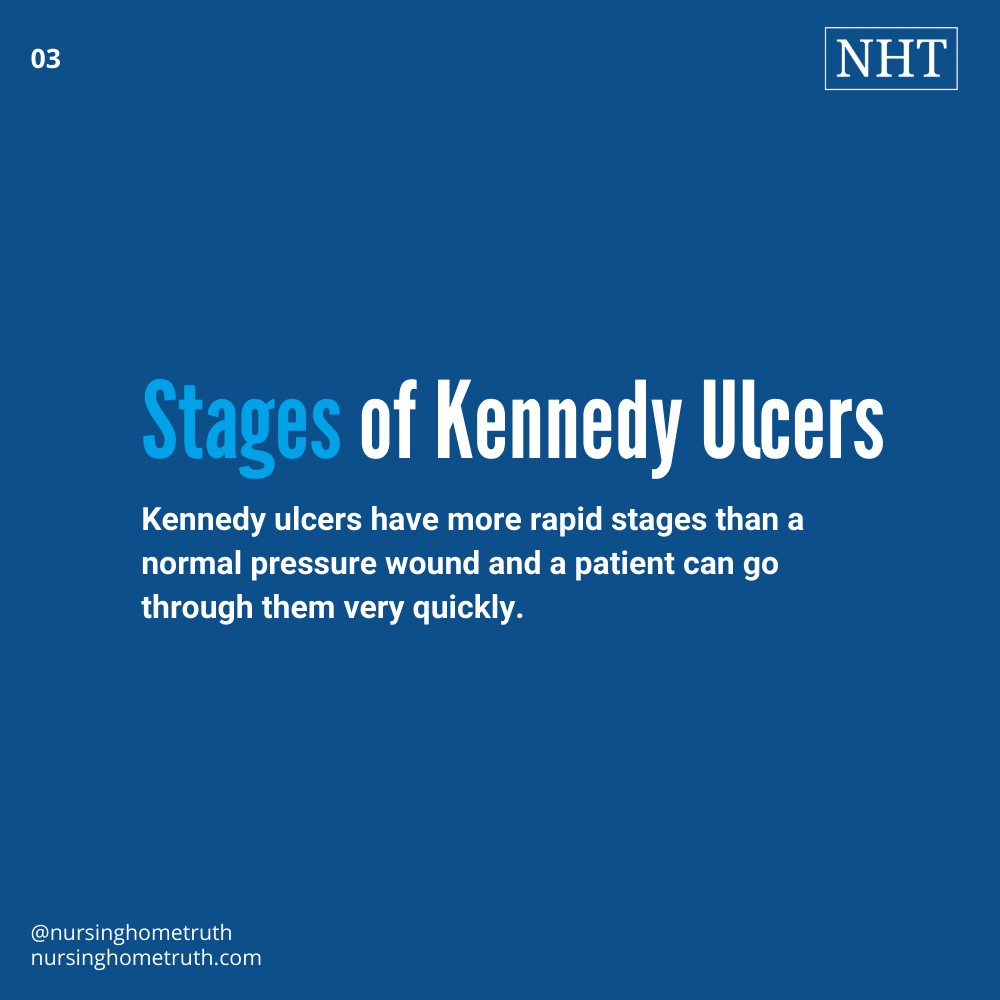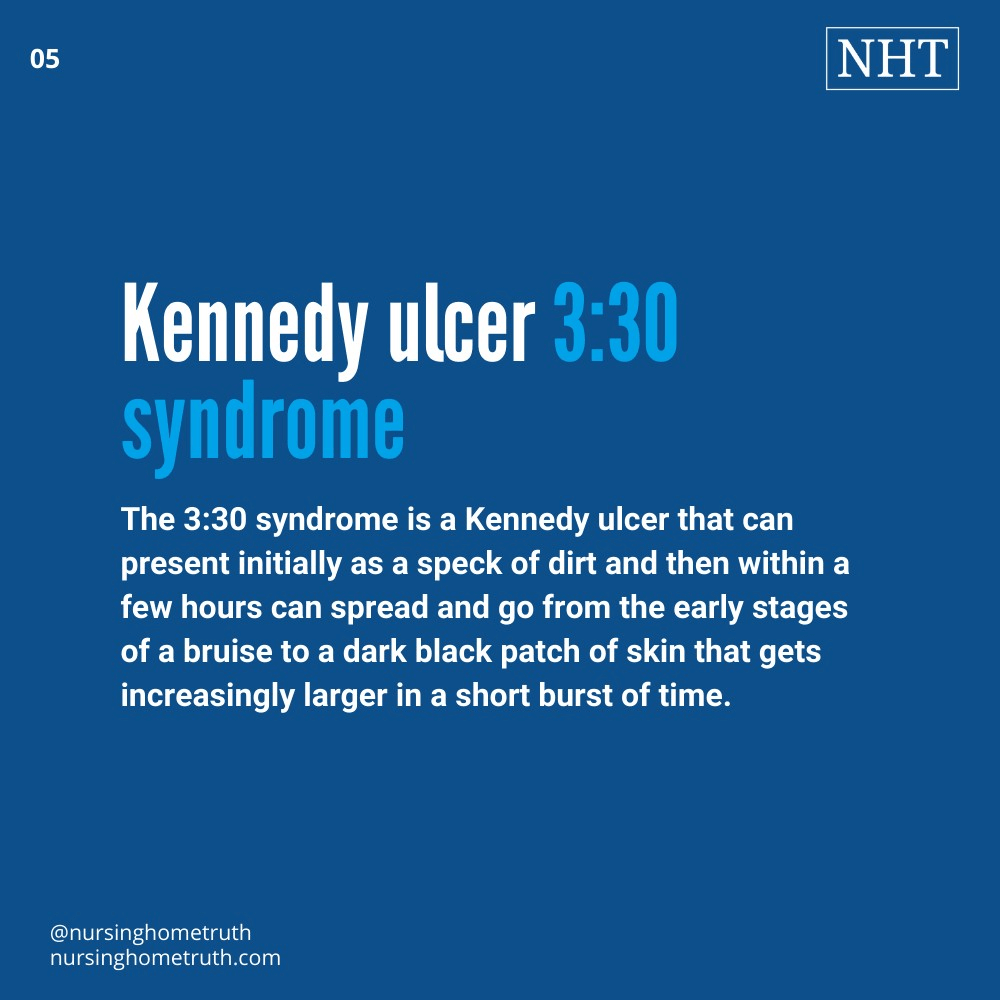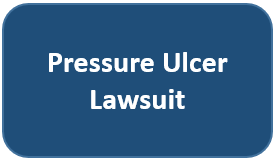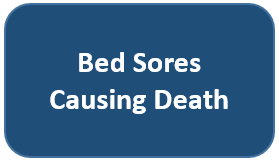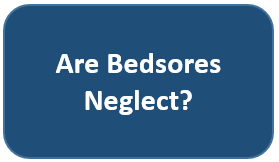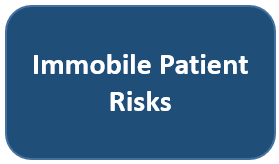Article Updated: November 14, 2023
Kennedy Ulcer Stages
If a nursing home is telling you that your family or friend has a Kennedy ulcer or died with a Kennedy ulcer, all kinds of red flags should be going up.
Why? Because that is usually what negligent nursing homes say to initiate a cover up of a pressure wound that was caused by malpractice.
Below, you will learn the difference between a true Kennedy ulcer versus a pressure wound.
If it’s the latter, nearly 99% of the time the medical facility was negligent and is trying to cover its tracks to trick you into not investigating what they did to your family member who was in the facility’s trusting care.
Clickable Table of Contents
Kennedy Ulcer Stages
1 – What is a Kennedy Ulcer?
2 – Kennedy Ulcer Stages
3 – Treatment of Kennedy Ulcers
4 – Survival Rate Of Kennedy Ulcer Patients
Resources
5 – Kennedy Ulcer Investigations
6 – Supporting Literature, Citations & Research
7 – About the Author
8 – Legal Help in Maryland & Nationally
What is a Kennedy Ulcer?
A Kennedy ulcer is specific kind of sore that can be called by names like pressure ulcer or pressure sore. However, these names may not at all be accurate because this kind of ulcer does not act in the same manner as other pressure wounds.
While a pressure wound normally needs pressure in order to develop, this is not always the case with the Kennedy ulcer. In fact, the Kennedy ulcer stages can develop far more rapidly than any normal pressure wound, sometimes in as few as 3-8 hours.
This major difference in the Kennedy ulcer stages and normal pressure ulcer stages are not fully understood as the medical community still believes that too much is unknown about Kennedy ulcers to make definitive statements about their causes and etiology.
Like pressure sores, the Kennedy ulcer is ultimately a breakdown and deterioration of the skin. The wound starts like a small bruise that can be reddish or brown, but quickly spreads and grows in a very short period of time.
Kennedy Ulcer Stages
Kennedy ulcers have more rapid stages than a normal pressure wound and a patient can go through them very quickly.
Like The Stages Of A Bruise
A Kennedy ulcer can have multiple stages which range in the same way that a bruise would range. There are colors common to the Kennedy ulcer which includes blue, purple, yellow, red, orange and deep blackish shades.
The later Kennedy ulcer stages will generally include darker blackish colors and swollen skin which itself is a sign of tissue death.
Kennedy ulcers tend to be considered a skin failure that is associated with acute and chronic illnesses or can also be a sign of the overall dying process in an individual.
Kennedy Ulcer 3:30 Syndrome
While most Kennedy ulcers tend to develop out of the blue and without warning begin to rapidly progress, some are even faster and more devastating.
A phenomenon known as the 3:30 syndrome is a Kennedy ulcer that can present initially as a speck of dirt and then within a few hours can spread and go from the early stages of a bruise to a dark black patch of skin that gets increasingly larger in a short burst of time.
A 3:30 syndrome Kennedy ulcer is often seen as a bed sore at end of life because a person with 3:30 syndrome Kennedy ulcers generally only has a life expectancy of 8-24 hours.
Treatment of Kennedy Ulcers
Treatment options for a Kennedy ulcer are limited. When a person has entered into the Kennedy ulcer later stages, it can often mean that this is an individual’s final stages of life.
In many people with a terminal Kennedy ulcer, there is an unavoidable skin breakdown which is happening as a part of the dying process and cannot be treated.
These final stages, also known as the unstageable periods, are usually accompanied with full thickness tissue loss and the presence of a layer of slough over the ulcer which can be yellow, brown or green in color.
When this happens, there is no treatment to actually address the ulcer anymore, and the plan of care shifts to ensuring comfort, respect and dignity in the final hours, days or weeks of life that a person has.
Survival Rate Of Kennedy Ulcer Patients
Kennedy Ulcers Precede Death
A Kennedy ulcer more often than not is a bed sore seen at end of life.
The Kennedy ulcer stages move so rapidly that it is often less a conversation about survival in any sense of the long-term and instead a conversation about short-term life extension.
A normal pressure wound can be related to poor care, being bedridden or having a short-term immobility issue. These wounds occur in people of all ages.
A Kennedy ulcer, however, is labeled as a pressure ulcer incorrectly in most cases because this name suggests the potential for effective treatment with a good survival rate. Neither of these are true in most Kennedy ulcer cases as those with a Kennedy ulcer are expected to die, not as a result of the Kennedy ulcer, but because of end of life deterioration overall.
Pressure Wounds do Not Precede Death
On the other hand, nursing homes often try to hide their malpractice by labeling a regular pressure wound as a Kennedy Ulcer. That’s the nursing home trying to lie and say, “this person was going to die anyway.”
Do not fall for this. Have a lawyer look at the medical records, the timeline of the ulcer, its progression, its coloration, size, and other features, to help you figure out if the nursing home is involved in a cover up.
Bed Sores In End of Life
At end of life there will be many rapid changes and deterioration in an individual and many of these will come to the skin in the final stages of life. One of these skin conditions that can come quickly and in a devastating manner are painful and mostly untreatable Kennedy ulcers.
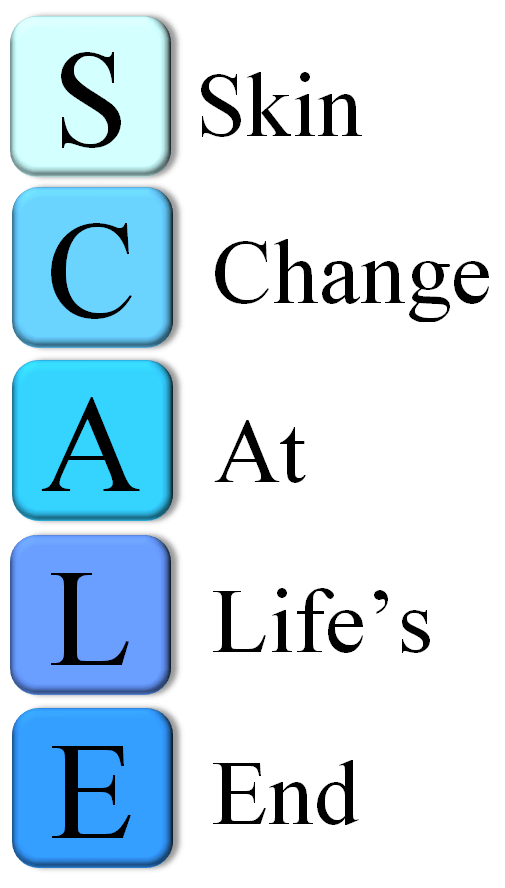
What is known is that this kind of ulcer is a sign of tissue death that can come on rapidly and has little to no treatment in the traditional sense of the word.
Rather, it is believed that a better way to understand the Kennedy ulcer is to see it as an end of life change in the skin that may not be treated with traditional preventative methods used on other pressure wounds.
Specifically, the Kennedy ulcer, along with a few other skin conditions are listed as a SCALE, or a skin change at life’s end which has its own needs and norms in nursing care and is a phenomenon that is still in need of extensive further research.
Because of the many unknowns with Kennedy ulcers, the most important aspect of them is to ensure that the individual who is suffering from them has the care and attention that they need to ensure their pain is managed.
Kennedy ulcers can be a warning that end of life is approaching yet despite there being no known treatment for them, patient’s can be assisted in this end of life event through proper, competent and compassionate nursing and medical practices.
This is all to say that, Kennedy Ulcers are in some sense an end of life bed sore, or at least in lay terms are sometimes called that. Nonetheless, the two (Kennedy Ulcers and bed sores) should not be confused because they are very different, as explained in this article.
Kennedy Ulcer Investigations
The million dollar question here is, did your family member have a Kennedy Ulcer when they died or did they die because they had a pressure wound and the nursing home is hiding that malpractice by calling the pressure wound a Kennedy Ulcer?
This is a real problem, and nursing homes will do this and many other shady and unethical things to hide their bad acts. Do not let them get away with it. Call me and let me conduct a FREE investigation for you. Nobody pays me a penny unless I get money for them from the negligent hospital and nursing home.
Whenever you are ready, I am here for you.
Warmly,
Reza Davani, Esq.
State Bar No.: #1212110211
Federal Bar No.: #30168
Cellphone: (301) 922-4598
Email: reza@nursinghometruth.com
Pressure Ulcer Legal Library
Click/Tap Icons to Access Articles

Supporting Literature, Citations & Resources:
Brennan, M. R., & Trombley, K. (2010). Kennedy Terminal Ulcers-a Palliative Care Unit’s Experience over a 12-month Period of Time. World Council of Enterostomal Therapists Journal, 30(3), 20-22.
Beldon, P. (2011). Skin changes at life’s end: SCALE ulcer or pressure ulcer?. British journal of community nursing, 16(10), 491-494.
Latimer, S., Shaw, J., Hunt, T., Mackrell, K., & Gillespie, B. M. (2019). Kennedy terminal ulcers: a scoping review. Journal of Hospice & Palliative Nursing, 21(4), 257-263.
Schank, J. E. (2016). The Kennedy Terminal Ulcer–Alive and Well. The Journal of the American College of Clinical Wound Specialists, 8(1-3), 54.
Ayello, E. A., Levine, J. M., Langemo, D., Kennedy-Evans, K. L., Brennan, M. R., & Sibbald, R. G. (2019). Reexamining the literature on terminal ulcers, scale, skin failure, and unavoidable pressure injuries. Advances in skin & wound care, 32(3), 109-121.
About the Author
This nursing home and medical malpractice article was written by Baltimore, Maryland nursing home attorney Reza Davani, Esquire. Mr. Davani received his Juris Doctor degree from a Tier 1 law school, the University of Maryland Francs King Carey School of Law. He received his first license to practice law from the State of Maryland’s Court of Appeals (MD State License No. 1212110211), and just four months later received a federal law license from the United States District Court for the District of Maryland (Federal License No. 30168).
Mr. Davani has been practicing law for over 10 years. He began practicing law by helping clients as a sanctioned student lawyer before receiving his law license, and second chaired his first jury trial in federal court before even graduating law school. He is a registered member of the Maryland Association for Justice (MAJ), the American Bar Association (ABA), the American Association for Justice (AAJ), and was formerly on the MAJ’s Legislative Leader’s Circle.
Mr. Davani has taken over 20 cases to trial in state and federal court, and favorably settled well over 100 cases for injured victims. He has personally helped his clients recover over $25,000,000 in personal injury, medical malpractice, and nursing home abuse settlements and verdicts in Maryland and other states. He is dedicated to fighting for justice, and welcomes the opportunity to help you.
About the Nurse Consultant
La kesha Dillard, started her nursing career in 1994 as a Home Health Aide (HHA). She enjoyed working with people so much that she earned her certification as a Certified Nursing Assistant (CNA). She attended Trocaire College and completed both (the LPN and RN) programs where she earned her LPN/RN AAS degree. She was motivated to further her education and in 2016 she received her baccalaureate degree in nursing from Daemen College Amherst, NY. In 2019 she successfully completed Chamberlain College of Nursing, Nurse Executive and Leadership program, and earned a Masters of Science in Nursing (MSN) degree.
Mrs. Dillard wanted to learn more about the business side of nursing, so she attended Devry University and received her Master of Business Administration (MBA) degree in 2023.
In 2021, she successfully completed the Vicky Millazo program where she earned her certification as a Legal Nurse consultant. She opened up her nurse consulting business in 2022 and is the proud owner, founder/CEO at Mrs. RN Consulting, LLC. La kesha has consulted and worked with many attorneys by helping them understand the medical records to get justice for their clients. She has worked at several Long-Term Care facilities (LTC), medical surge units and has several years of experience with patient care and consulting.
She is a strong advocate for patients and believes in Person-Centered Care (PCC) at all times. La kesha is also a tough upholder for staff rights, and she continues to motivate nurse entrepreneurs to further their education in nursing.
Medical Malpractice Nursing Home Abuse Lawyer Near You in Baltimore, Maryland & Beyond
I can help you anywhere in Maryland, including Allegany County, Anne Arundel County, Baltimore City, Baltimore County, Carroll County, Calvert County, Caroline County, Cecil County, Charles County, Dorchester County, Frederick County, Garrett County, Harford County, Howard County, Kent County, Montgomery County, Prince George’s County, Queen Anne’s County, Somerset County, St. Mary’s County, Talbot County, Washington County, Wicomico County, and Worcester County.
I have helped clients in over a dozen jurisdictions, including California, Delaware, District of Columbia, Georgia, Illinois, Iowa, Massachusetts, Maryland, Mississippi, New Jersey, New Mexico, New York, North Carolina, Pennsylvania, South Carolina, Washington, and Virginia.
I help injured victims nationwide in all 50 states on a case-by-case basis via Pro Hac Vice.



